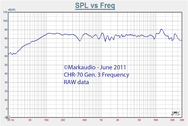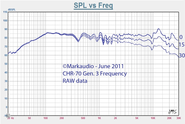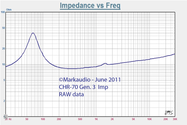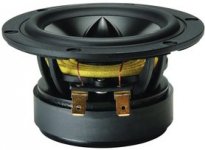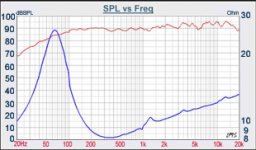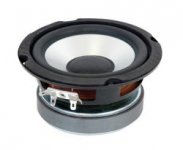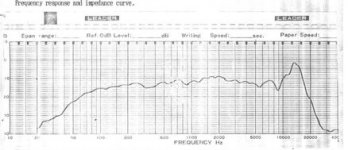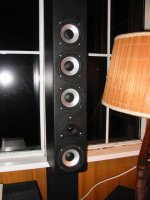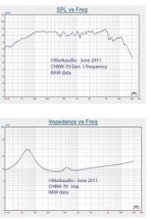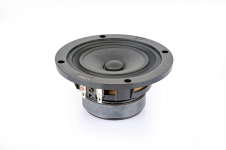Is this as good as it gets in 4" Full range ?
I am looking for the best for closed box
Has an EBP of 94 only 4 points from being suited for both closed box or bass reflex although the Xmax seems high for a sealed box at 4.3mm one way.
an Fs of 65.40 and Qes of 0.69 and Vas of 5.17 ltrs
The curve on this looks honest and incredible and it is only 36.00
If you or someone you know has used this driver in a closed box setup sure would like to hear a quick review
Is it just me or does that cone color look Ugly ?
I am looking for the best for closed box
Has an EBP of 94 only 4 points from being suited for both closed box or bass reflex although the Xmax seems high for a sealed box at 4.3mm one way.
an Fs of 65.40 and Qes of 0.69 and Vas of 5.17 ltrs
The curve on this looks honest and incredible and it is only 36.00
If you or someone you know has used this driver in a closed box setup sure would like to hear a quick review
Is it just me or does that cone color look Ugly ?
Attachments
Last edited:
Your images are kind of small to see but I can barely make out that you are referring to the MA CHR-70, certainly a very well liked driver around here and appears to be a great value. It has a more expensive brother called the Alpair 7 that many people like too. If you are going to use it sealed, you won't get to experience the low bass extension it is capable of, but that is fine for use with a helper woofer. When you say is this as good as it gets, just make sure you are aware that some folks object to the peak at 12 kHz which can vary by 20 dB over the different angles of off axis listening. The data is presented from -10dB to +110dB a rather large scale that visually flattens a response. Most people agree that this is a great sounding driver and is very versatile for use in BR or TL alignments. If you are looking for a flat response from a driver for a sealed box with circa 85 dB efficiency, take a look at the Vifa TC9FD. It costs a lot less but the smoothness and low harmonic distortion are among the best of a driver at any price in the 3 to 4 inch range. Here is the response of the TC9FD in a sealed spiral TL cabinet:
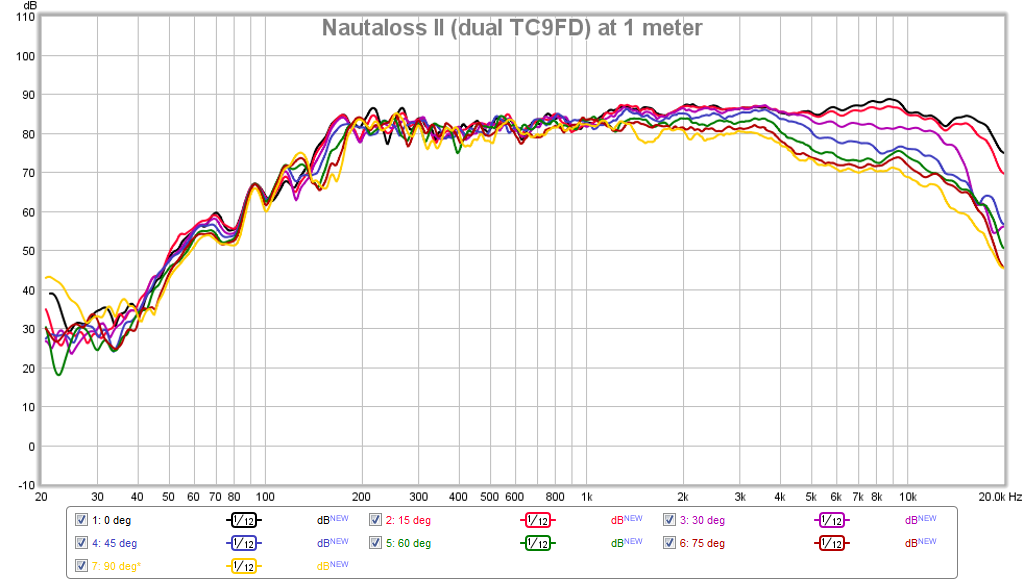
Another driver worth looking at with great smooth response and ideal for sealed boxes is the Faital Pro 4FE35. Both the TC9FD and FE35 also work well in an open baffle.

Another driver worth looking at with great smooth response and ideal for sealed boxes is the Faital Pro 4FE35. Both the TC9FD and FE35 also work well in an open baffle.
You know the Faital Pro , I actually liked it but just could not see how to make it attractive with that awful looking mounting basket, but the product does look worthy I will say that. and although they seem to be very well regarded the TB drivers all seem to have incredibly smooth response curves almost all of them and I still may go with a couple TB . I just have to believe that most drive units are going to experience turbulence, both minor and slightly major along their curve that is just the way it is.
thanks for taking the time to reply
thanks for taking the time to reply
Depends what you mean by 'good as it gets' since that varies with opinion, requirements and personal taste. All drive units are different. The Mark Audio units are however, very good examples of what they are.
The CHR linked to is their entry-level metal-cone model in the 4in size bracket (Alpair 7 is the range-topper) -you can get it in an off-gold colour if you don't like the grey.
The graphs are honest for what they are; there's no software smoothing applied, but the vertical / dynamic scale is larger than you'd usually get with a midbass or tweeter (providing a similar effect) -this is normal practice for wideband driver unit manufacturers.
Re EBP, don't pay much attention to it. It's at best a very simplistic 1st pass approximation. The CHR does fine in both sealed and vented boxes however.
The CHR linked to is their entry-level metal-cone model in the 4in size bracket (Alpair 7 is the range-topper) -you can get it in an off-gold colour if you don't like the grey.
The graphs are honest for what they are; there's no software smoothing applied, but the vertical / dynamic scale is larger than you'd usually get with a midbass or tweeter (providing a similar effect) -this is normal practice for wideband driver unit manufacturers.
Re EBP, don't pay much attention to it. It's at best a very simplistic 1st pass approximation. The CHR does fine in both sealed and vented boxes however.
TB do make some very nice drive units, but their published data is generally 'optimistic.' 
As for deviations from a flat response: right. All widebanders do. No exceptions. Theoretically, the smaller ones should (should) have the least, assuming a flat response was targeted in the first place & the design & manufacturing are competent. As you go larger, it becomes progressively more difficult to do it. Wideband drive units rely on controlled resonance to produce the high frequencies. That's not easy (classic understatement there), especially with a large cone. And you get variations even in the same size bracket.
Take, for e.g., the Vifa TC9 referred to above by X. This is about the flattest in terms of FR that you can get from a widebander (and very impressive it is too). The Mark Audio Alpair 6P is in the same size bracket, and is also good, albeit not quite as linear in response terms. They have exactly the same Sd (36.3cm^2). Vifa doing a better job? Depends. Because they're not the same. Compare Mms and Xmax for a moment:
TC9 is a featherweight 2.6g and has 2.55mm Xmax.
A6P is even lighter at 2.32g, but has a much longer coil & suspension travel: Xmax is 10mm. It's also a little more efficient, translating into an extra 1.5dB sensitivity or so in practice, along with the greater LF extension &c.
So something has to give. The TC9 is a more highly damped design, & less micro-resonant sensitive than the 6P. This provides that very linear FR & impressive distortion performance, but 'detail' (I don't like the term, but you get the idea) is somewhat less. Horses for courses and no reflection on either unit -they are what they are and the options are there for people to select what suits their needs best. Amongst many others -I used these as a quick example because I had the data to hand & they share the same Sd.
As for deviations from a flat response: right. All widebanders do. No exceptions. Theoretically, the smaller ones should (should) have the least, assuming a flat response was targeted in the first place & the design & manufacturing are competent. As you go larger, it becomes progressively more difficult to do it. Wideband drive units rely on controlled resonance to produce the high frequencies. That's not easy (classic understatement there), especially with a large cone. And you get variations even in the same size bracket.
Take, for e.g., the Vifa TC9 referred to above by X. This is about the flattest in terms of FR that you can get from a widebander (and very impressive it is too). The Mark Audio Alpair 6P is in the same size bracket, and is also good, albeit not quite as linear in response terms. They have exactly the same Sd (36.3cm^2). Vifa doing a better job? Depends. Because they're not the same. Compare Mms and Xmax for a moment:
TC9 is a featherweight 2.6g and has 2.55mm Xmax.
A6P is even lighter at 2.32g, but has a much longer coil & suspension travel: Xmax is 10mm. It's also a little more efficient, translating into an extra 1.5dB sensitivity or so in practice, along with the greater LF extension &c.
So something has to give. The TC9 is a more highly damped design, & less micro-resonant sensitive than the 6P. This provides that very linear FR & impressive distortion performance, but 'detail' (I don't like the term, but you get the idea) is somewhat less. Horses for courses and no reflection on either unit -they are what they are and the options are there for people to select what suits their needs best. Amongst many others -I used these as a quick example because I had the data to hand & they share the same Sd.
Last edited:
This is another drive unit on my list even carries a 5 yr warranty and if I am not mistaken TB makes these for Dayton
Nominal Diameter 4"
Power Handling (RMS)30 Watts
Power Handling (max)60
WattsImpedance8 ohms
Frequency Response 87 to 20,000
HzSensitivity 85.6 dB 1W/1m
Voice Coil Diameter1"
THIELE-SMALL PARAMETERS
Resonant Frequency (Fs) 87.5
HzDC Resistance (Re) 6.05 ohms
Voice Coil Inductance (Le) 0.48
mHMechanical Q (Qms) 2.52
Electromagnetic Q (Qes) 0.71
Total Q (Qts) 0.55
Compliance Equivalent Volume (Vas) 0.09 ft.³
The quality of drive units that are currently available today were unimaginable back in 1988 when I was into all this, just have to wonder what 20 more years will bring to Transducer technology
Nominal Diameter 4"
Power Handling (RMS)30 Watts
Power Handling (max)60
WattsImpedance8 ohms
Frequency Response 87 to 20,000
HzSensitivity 85.6 dB 1W/1m
Voice Coil Diameter1"
THIELE-SMALL PARAMETERS
Resonant Frequency (Fs) 87.5
HzDC Resistance (Re) 6.05 ohms
Voice Coil Inductance (Le) 0.48
mHMechanical Q (Qms) 2.52
Electromagnetic Q (Qes) 0.71
Total Q (Qts) 0.55
Compliance Equivalent Volume (Vas) 0.09 ft.³
The quality of drive units that are currently available today were unimaginable back in 1988 when I was into all this, just have to wonder what 20 more years will bring to Transducer technology
Attachments
Last edited:
Of course. None of them would sell any drive units if they didn't. As I said in Post 5:
This is normal practice for wideband drive unit manufacturers.
I guess what I am really asking is if I get a couple drive units from any mfg and put them on the woofer tester am I going to be in shock, feel like I got took or glad I went with that particular Mfg. and those curves provided by Mfg are pre broken in or post broken in drive units ?
Depends based on the tester, driver manufacturer, production tolerances, measurement setup &c.
I wouldn't assume manufacturer data is going to be more accurate than home. Equally, I wouldn't assume home measurements are automatically 'better' than those of a manufacturer either. For example, most manufacturers take T/S data as a batch average or similar (so the data doesn't always line up), and at a high (realistic) voltage, where home gear usually tests at a lower voltage. T/S parameters are not fixed; they vary with such things. Likewise, FR graphs from manufacturers are usually anechoic, from a full chamber, typically on an IEC standard baffle. Wideband manufacturers generally use LMS (Tang Band, Fostex, MA & others) with extremely expensive microphones significantly better than what most of us have access to. But the data is usually presented in a positive way. Fair enough. They are businesses, not charities. So there's an offset there -we don't have the same gear, but we're more objective (or can be), assuming it's done properly. YMMV.
If you want data that lines up very closely, the TC9 is about as near as you're likely to get -partly in terms of how Vifa present it, and the type of driver that it is. Assuming you apply the same measurement conditions / criteria, the MA & Fostex are usually more-or-less there. Tang Band can (can) see more variability. But as a rule, few who buy widebanders are especially bothered about perfection in response or the specifics of the measures; it's a somewhat different approach & mindset from multiways (I design & use both).
I wouldn't assume manufacturer data is going to be more accurate than home. Equally, I wouldn't assume home measurements are automatically 'better' than those of a manufacturer either. For example, most manufacturers take T/S data as a batch average or similar (so the data doesn't always line up), and at a high (realistic) voltage, where home gear usually tests at a lower voltage. T/S parameters are not fixed; they vary with such things. Likewise, FR graphs from manufacturers are usually anechoic, from a full chamber, typically on an IEC standard baffle. Wideband manufacturers generally use LMS (Tang Band, Fostex, MA & others) with extremely expensive microphones significantly better than what most of us have access to. But the data is usually presented in a positive way. Fair enough. They are businesses, not charities. So there's an offset there -we don't have the same gear, but we're more objective (or can be), assuming it's done properly. YMMV.
If you want data that lines up very closely, the TC9 is about as near as you're likely to get -partly in terms of how Vifa present it, and the type of driver that it is. Assuming you apply the same measurement conditions / criteria, the MA & Fostex are usually more-or-less there. Tang Band can (can) see more variability. But as a rule, few who buy widebanders are especially bothered about perfection in response or the specifics of the measures; it's a somewhat different approach & mindset from multiways (I design & use both).
Last edited:
I was quite surprised yesterday to do a T/S run on a single FF85WK, well broken-in by now. It's about the closest I ever came to factory spec. Measured at ~2V:
Loudspeaker parameters:
Fs = 115.89 Hz
Re = 7.50 ohms[dc]
Le = 154.52 uH
L2 = 144.24 uH
R2 = 4.41 ohms
Qt = 0.60
Qes = 0.68
Qms = 5.10
Mms = 1.98 grams
Rms = 0.292124 kg/s
Cms = 0.000946 m/N
Vas = 1.04 liters
Sd= 27.99 cm^2
Bl = 4.063108 Tm
ETA = 0.24 %
Lp(2.83V/1m) = 86.16 dB
Added Mass Method:
Added mass = 10.00 grams
Diameter= 5.97 cm
Ok, not quite a 4" driver. Here's TB W4-1320SIF, near-field on-axis:
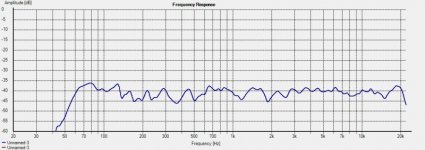
I'd call that flat. It does lose the topmost HF to beaming pretty fast, if you move off-axis.
Frequency response is not everything, but it's always nice if it turns out pretty, all else being the same - which it rarely is, but that's another story.
Loudspeaker parameters:
Fs = 115.89 Hz
Re = 7.50 ohms[dc]
Le = 154.52 uH
L2 = 144.24 uH
R2 = 4.41 ohms
Qt = 0.60
Qes = 0.68
Qms = 5.10
Mms = 1.98 grams
Rms = 0.292124 kg/s
Cms = 0.000946 m/N
Vas = 1.04 liters
Sd= 27.99 cm^2
Bl = 4.063108 Tm
ETA = 0.24 %
Lp(2.83V/1m) = 86.16 dB
Added Mass Method:
Added mass = 10.00 grams
Diameter= 5.97 cm
Ok, not quite a 4" driver. Here's TB W4-1320SIF, near-field on-axis:

I'd call that flat. It does lose the topmost HF to beaming pretty fast, if you move off-axis.
Frequency response is not everything, but it's always nice if it turns out pretty, all else being the same - which it rarely is, but that's another story.
Last edited:
5'' Aluminum Cone Woofer
MCM.....55-1870
Features
Aluminum cone
Synthetic dust cap
Rubber surround
Stamped steel basket
1" voice coil
15.6oz. magnet
Specifications
Power Capacity: 50W/100W RMS/peak
Sensitivity: 87dB (W/M)
Impedance: 8ohm
Re: 6.7ohm
Le: 0.59mH
Frequency response: 55Hz~17KHz
Fs: 55Hz
Qts: 0.40
Qes: 0.51
Qms: 1.87
Vas: 10.04 (liters)
Xmax: 2.0mm
Dimensions
Overall frame diameter: 5.14"
Required cutout: 4.21"
Mounting depth: 2.52"
4" or 5" is what I am hunting for and this 5" although old technology compared to what is being made now sure has a bunch of good reviews from owners . put it on my list but not at the top of the list.
MCM.....55-1870
Features
Aluminum cone
Synthetic dust cap
Rubber surround
Stamped steel basket
1" voice coil
15.6oz. magnet
Specifications
Power Capacity: 50W/100W RMS/peak
Sensitivity: 87dB (W/M)
Impedance: 8ohm
Re: 6.7ohm
Le: 0.59mH
Frequency response: 55Hz~17KHz
Fs: 55Hz
Qts: 0.40
Qes: 0.51
Qms: 1.87
Vas: 10.04 (liters)
Xmax: 2.0mm
Dimensions
Overall frame diameter: 5.14"
Required cutout: 4.21"
Mounting depth: 2.52"
4" or 5" is what I am hunting for and this 5" although old technology compared to what is being made now sure has a bunch of good reviews from owners . put it on my list but not at the top of the list.
Attachments
I'd call that flat. It does lose the topmost HF to beaming pretty fast, if you move off-axis.
with a curve like that did you have an idea just how good it was while listening to it, because you seemed surprised at the test result , that is why I ask.
Attachments
Last edited:
with a curve like that did you have an idea just how good it was while listening to it, because you seemed surprised at the test result , that is why I ask.
I was surprised at the T/S parameters of FF85WK, but this SPL trace is TB W4-1320SIF.
As for the initial "listening to that curve", it certainly was very different from the previous speaker's (FF125K in small mis-tuned reflex) midrange-forward presentation, but I could feel greater balance for sure.
I've ameliorated the FF125K since and have been listening to that one lately (my current avatar):
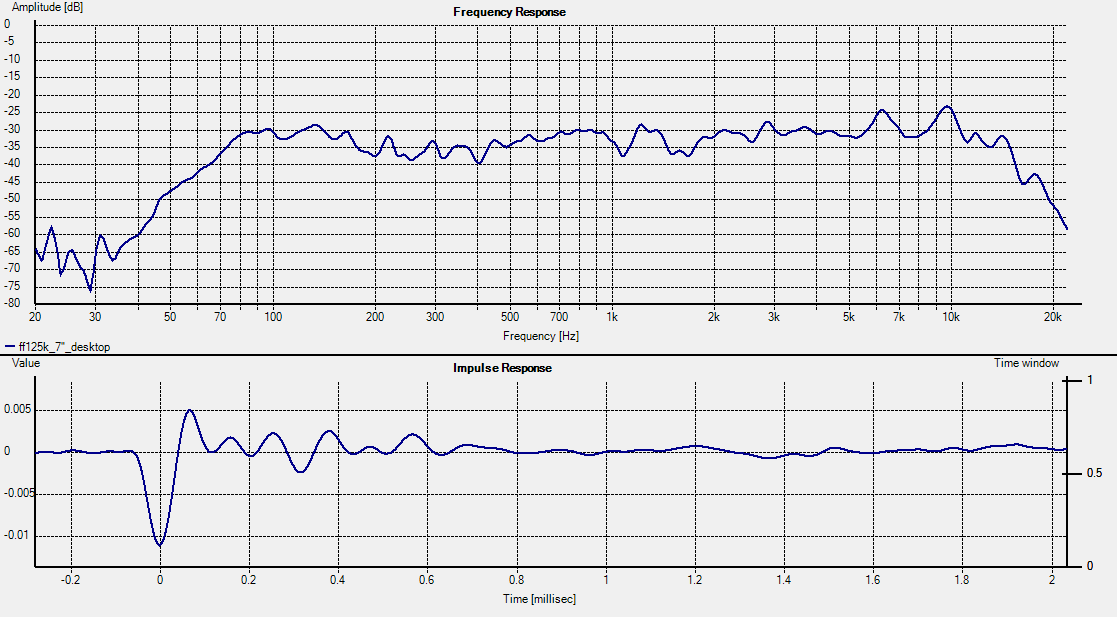
Not as even as the TB, but as said, frequency-domain response is far from everything. I like the Fostex better overall, with more detail and significantly more sensitivity.
I use those in my HT set-up but I don't use them for music. Not sure I can describe them but they just don't sound as good as they look. My take on it only.5'' Aluminum Cone Woofer
MCM.....55-1870
Attachments
Hey
this is true imho:
Regards
this is true imho:
but some manufactures are more "honest" in there graphs then others is my experience. From what i have seen in german hifi forums and magazins and also here is that Ma tends to smooth out the graphs quiet a bit. Another problem imho is that some manufactures like Ma keep developing their drivers in quick succesion which results in constantly change specs which in turn makes it very difficult to use a developed speaker / cabinet / cross over for longer since the "old" driver is off the market. Sometimes i feel that within one and a half years the driver is off the market so if you want to replace a broken driver or build another set of speakers you have to build different speakers...LOL everyone's data is Optimistic....including MA.
Regards
I use those in my HT set-up but I don't use them for music. Not sure I can describe them but they just don't sound as good as they look. My take on it only.
May depend on the age. IIRC when the 1870 was first developed, it had a curvilinear cone; at some point that got junked and performance suffered, which is why Bottlehead gave up.
Yet another real possibility and it is a normal color
CHBW-70 1st Generation Wide Range Audio Driver, 4", Black paper cone.
Imp - 8 Ohm
Fs - 66Hz
Qts - .49
Vas - 4.6L
SPL - 84.8dB
Xmax - 2mm
Qes - 0.69
This one looks like a real good one EBP of 96 so could use as sealed box unit.
CHBW-70 1st Generation Wide Range Audio Driver, 4", Black paper cone.
Imp - 8 Ohm
Fs - 66Hz
Qts - .49
Vas - 4.6L
SPL - 84.8dB
Xmax - 2mm
Qes - 0.69
This one looks like a real good one EBP of 96 so could use as sealed box unit.
Attachments
- Status
- This old topic is closed. If you want to reopen this topic, contact a moderator using the "Report Post" button.
- Home
- Loudspeakers
- Full Range
- Is this as good as it gets in 4 " Full range ?
